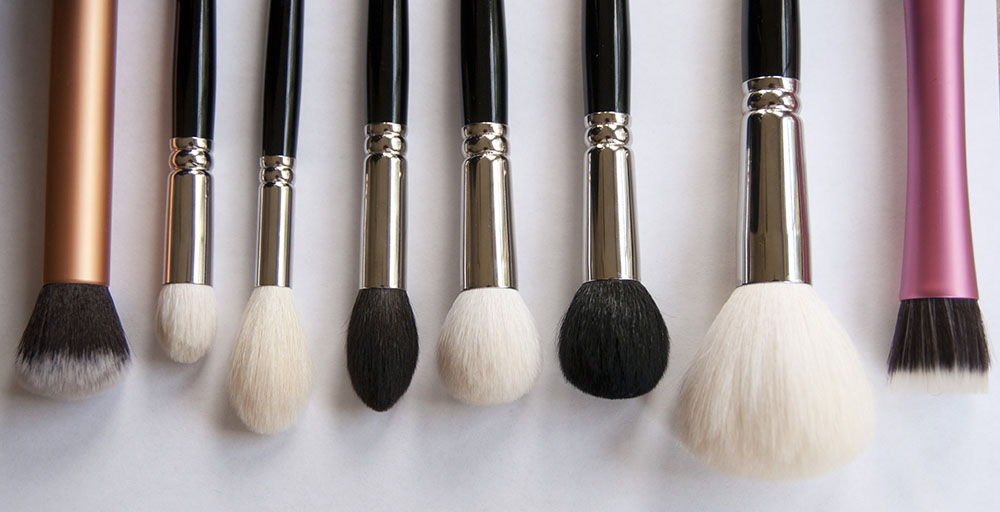
All About Brushes: How to Choose a Brush
Hands-down the most common question that people ask: What brush/set should I buy? I always hesitate to give blanket recommendations because everyone’s needs and budgets vary. The real secret is determining what your needs are, so here are some things to think about when you’re in the market for new brushes.
Natural vs Synthetic
I’m putting this one at the top because even though not everyone requires synthetic brushes, when you do, it’s generally the top criteria. One of the most common reasons that people look for synthetic-bristle brushes is because they don’t contain any animal hair and therefore no animals were harmed in making them. It’s important to note that not all synthetic brushes are made by entirely cruelty-free companies – some may have synthetic brush lines while still using animal testing for other products. Whether that’s an acceptable compromise is a personal choice. There are also some people who have allergic reactions to the animal hairs in some natural brushes, which makes synthetic a better option. Some companies that carry a full range of synthetic brushes are Eco Tools, Real Techniques, Sigma, and Make Up For Ever.
Your skin type
If your skin is very sensitive, you may want to look for softer hair types like squirrel or high-quality synthetic bristles, since they generally cause less irritation. The same goes for skin that’s dry or dehydrated since it can tend to flake easily – stiff or scratchy bristles can make flakes more visible, but a soft brush with a little more ‘give’ can help limit that.
What products will you be using it for?
Will you be using the brush for powder or cream products, or both? Cream and liquid products tend to build up more on bristles and are more difficult to remove, so brushes used with them will need more frequent washing. Synthetic bristles and sturdier hair types like weasel, goat or horse would be appropriate choices. The type of application you’re looking for (heavy vs light) will also drive your brush choice. Things like highlighters or very pigmented blushes can be easier to apply with a less dense brush, for example.
Shape & Size
As we’ll see later in the series, the size and shape of the brush plays a big part in how it applies product. You wouldn’t use a blush brush to smudge shadow under your lower lash line, now would you? I don’t want to get too ahead of myself, so for now just trust me – the size, shape and density you’ll want depend largely on the product you’re using and where it’s going on your face.
Quality
Most brushes will last a long time and be perfectly functional, but high-quality brushes should last longer (with appropriate care) and are just more pleasant to use. So what are some signs of good quality?
Hair quality – the hair should be soft and comfortable when used on the skin. Natural hair tips are very fine, so brushes shaped with the natural tips intact are usually softer than hair that has been laser-cut into a specific shape. The hairs should be tightly bound and glued into the ferrule. It isn’t uncommon for quality brushes to shed a few hairs in the first couple washes, but excessive shedding during use is a sign of a low-quality brush.
Ferrule – the ferrule should be made of a corrosion-resistant material like brass (strongest), nickel, or aluminum (weakest). It should be tightly joined to the handle, and not move at all if you tug it gently or attempt to rock it back and forth. Seamless ferrules, which are one solid piece of metal all the way around that are crimped onto the handle, are more durable than seamed ferrules since they don’t allow water and ‘gunk’ to damage the glue holding everything together.
Handle – should be a comfortable length and weight, and made from a durable material.
Aesthetics
In my opinion function is way more important than form when it comes to brushes, but I also like them to look nice. After all, they are one of the few things that are sitting in plain sight on my vanity. As you build your collection, you might discover that you prefer to have all of your brushes from the same manufacturer, have the same color handles, etc.
Price
Price is always a consideration (wouldn’t it be nice if it weren’t?). For beginners, I recommend experimenting with inexpensive brushes a bit to learn about your preferences before buying higher-end ones. A lot of drugstore brands like Eco Tools and Real Techniques have very decent quality at a low price point. Once you get familiar with your needs (need a stiffer lip brush, or a denser/smaller blush brush?) it makes sense to invest in the highest-quality brushes that fit into your budget, starting with the ones that are most essential to creating your daily looks.
A note on brush sets
Brush sets can be a great value… or not. Some brands cut corners on the quality of their seasonal brush sets in order to offer a steep discount, while other brands’ sets are the exact same brushes that you’d get if you bought them individually. Assuming the set includes brushes that are the same quality as the individuals, you really have to look at what’s included in the set and determine if you need it. For example, one of my favorite brands carries an 8-brush set at a pretty decent discount from the regular price. Great deal, right? Well, four of the brushes are a lash comb, a spoolie, a brow brush, and a pencil eyeshadow brush. The first three I don’t need, and the last one I already own. For the four brushes out of the set that I’d actually use, it ends up being a lot cheaper to just buy them individually.
Still not sure what to get, huh?
Research, research, research. Once you narrow down your picks to a few brushes, start reading reviews. Makeupalley has tons, and you can usually find reviews for most brushes on various blogs. If possible, go to the store and touch the brushes/test them out. And when all else fails, check the store’s return policy before you buy – a lot of places will let you return stuff if it doesn’t work out.

Leave a Reply